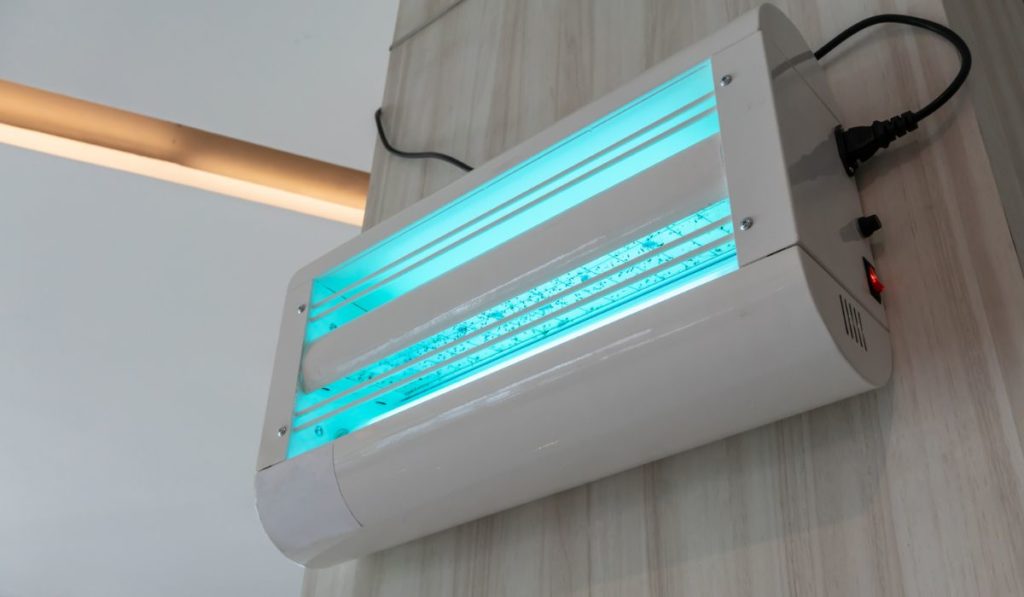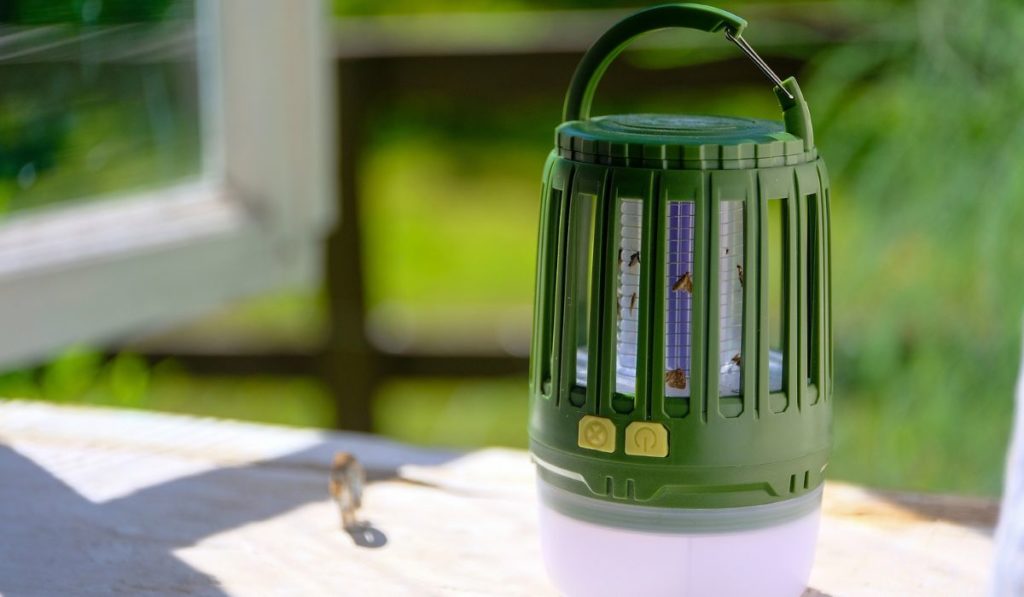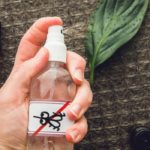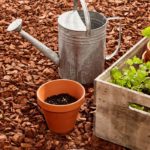Mosquitoes are some of the most annoying pests out there, and getting them to stay away can be very tough. Mosquito traps are one great solution to this problem, but with so many options out there, how can you decided which one’s best for you?
The most effective mosquito traps for outdoor areas are propane-fueled carbon dioxide traps, which are costly but can cover a very wide area. For indoor areas, you should use light- or heat-based mosquito traps, since carbon dioxide in inclosed spaces can be dangerous to human health.
Choosing a mosquito trap for your home can seem daunting, but once you’ve got one set up, you’ll be so glad you did. Let’s break it down in order to help you make a more informed decision on what to buy and what to avoid.
How Does a Mosquito Trap Work?

Mosquitoes are drawn to humans and animals by detecting the chemicals we give off, the heat produced by warm-blooded animals, or certain light frequencies. Mosquito traps lure the insects in by mimicking one of these three things, and then they keep the mosquitoes from leaving.
Once mosquitos are stuck in the trap, there are actually several different potential outcomes, depending on what trap you buy. They can be drawn in to be zapped by electricity; they can be lured into water to drown; or they can simply starve to death. No matter how the traps work, the mosquitoes aren’t making it out.
What Are the Different Types of Mosquito Traps?
There are many types of mosquito traps, including carbon dioxide traps, heat and light traps, paper traps, water traps, and homemade traps. Let’s quickly run through them all to help you understand the difference.
Carbon Dioxide Mosquito Traps
Carbon dioxide mosquito traps focus on the fact that when looking for prey, mosquitoes often search for the carbon dioxide that humans exhale. These traps emit carbon dioxide to lure hungry mosquitoes in. Carbon dioxide traps typically cost the most, but they also typically cover the most distance when it comes to catching mosquitoes’ attention.
There are some important warnings to consider before using a carbon dioxide mosquito trap. Certain carbon dioxide traps are fueled by propane. Be careful with these as they will be highly flammable.
Another important warning to note is that these carbon dioxide shouldn’t be used indoors. Generating too much carbon dioxide in your home can be a serious health risk, so stick to outdoor use with these traps.
Heat and Light Mosquito Traps
Heat and light mosquito traps are the traps most people imagine when they think of mosquito traps. They attempt to use UV light and heat to imitate the warmth that a human body would give off. This draws the mosquitoes in and then zaps them once they approach.
Paper Traps
Using flypaper traps to catch mosquitoes may seem like a bargain due to how cheap they are, but these traps are not actually recommended to trap mosquitoes. The sweet substance on the sticky yellow strips are mainly designed to catch the common housefly, and they’re not very effective at catching mosquitoes.
However, if you’re working on a tight budget, these may be worth trying out.
Water Mosquito Traps
Mosquitoes love to gather around sources of standing water, since water is a great place for their larvae to grow and develop. For most sources of standing water in your outdoor area, it’s recommended that you empty them when they’re not in use. However, for certain things like outdoor fish ponds and bird baths, that may not be an option.
To solve this problem, mosquito dunks were created. Mosquito dunks are little capsules that, when submerged in water, disperse a natural larvicide throughout the water. This makes the water toxic for mosquito larvae, but it won’t make the water toxic for any fish, birds, or any other animals who may drink from it.
Homemade Mosquito Traps
Homemade mosquito traps are less effective than the previous options we described, but they’re still worth mentioning. These are made by combining yeast and sugar to create carbon dioxide. This carbon dioxide then draws mosquitoes into a pool of water where they drown.
Where Should You Put a Mosquito Trap?
One important thing to consider when placing a mosquito trap outdoors is the wind. If you place a mosquito trap upwind, the mosquitoes won’t be able to get to it.
The most important thing you want a mosquito trap to do is to naturally draw in mosquitoes. That’s why it’s recommended that you place a mosquito trap downwind; that way, the mosquitoes can easily get to it.
If you’re unsure about the wind or don’t want to have to think about it, you can always place a fan pointing towards the trap. This will quite literally blow mosquitoes towards the trap, making it quite an efficient process.
It is also worth noting that mosquitoes like dark, shady places. This means that dark, shady places are optimal for trap placement. It’s even better if you’re using a heat and light mosquito trap, since there won’t be any other lights to distract the mosquitoes from the trap.
How Expensive Are Mosquito Traps?
This depends on the type of trap you want and how fancy you’re willing to get. The cheapest heat and electric bug zappers are around $30-$40. However, there are some really fancy ones that’ll run you around $150. These usually have a much larger radius than the cheaper kind, although some simply run a higher price for brand recognition.
Propane-powered carbon dioxide traps are much more expensive than the others — usually somewhere in the ballpark of $100 to $500. You’ll also need to pay for propane to fuel it, which is a substantial cost.
Nonetheless, these propane traps usually cover an insane amount of ground. This Mosquito Magnet MM4200B (on Amazon), for example, claims that it can protect you from mosquitoes for up to one acre.
Another downside to outdoor traps is the high electricity cost. These traps will need to be run for long periods of time in order to effectively control a mosquito population. Indoor mosquito traps usually don’t need to be run for nearly as long and don’t need nearly as much power, making them much cheaper.
Are Mosquito Traps Dangerous?

As mentioned earlier, propane-fueled carbon dioxide traps can be dangerous for human health, but only if used in enclosed spaces. This is because they generate large amounts of carbon dioxide to attract mosquitoes, which can be extremely bad for you if you’re constantly breathing it in. That’s why these traps are only recommended for outdoor spaces.
Since these traps are fueled by propane, they are also extremely flammable. That means any spark near them could cause the traps to ignite, so don’t light up any smokes near them.
Other than that, mosquito traps are usually pretty harmless. However, there are several mosquito repellant sprays that can be toxic for pets. Many mosquito repellant sprays are made using a chemical called DEET, which mosquitoes aren’t very big fans of.
However, this chemical has been linked with an increase in neurological problems in both cats and dogs who have been sprayed with it.
If you need a mosquito repellant that won’t harm your furry friend, natural plants like basil, catnip, lemon balm, and rosemary can drive mosquitoes away — and they’re perfectly safe for both cats and dogs.
Are There Natural Mosquito Traps?
There are several natural mosquito traps out there, and some you can even make yourself. Let’s go through a few of these to help you make your own.
Brown Sugar & Yeast Bottle Trap
This trap is one of the easiest to make. In order to make one, take a two-liter bottle of soda, cut off the top third, and put it in the bottle upside down.
This should create a funnel into the bottom two thirds of the bottle. Next gather 1 cup of brown sugar, 1 tablespoon of dry yeast, and 4 cups of water. Mix these and stir until they’re combined, then pour them into the bottle.
The brown sugar and the yeast should react, creating carbon dioxide, which will cause mosquitoes to enter the funnel. They will then get stuck in the water you put in.
The Amish Flying Insect Trap
This option is supposed to be the most effective homemade mosquito trap. In order to make this trap, you’ll need 1 cup of vinegar, 1 cup of sugar, 2 banana peels, 2 cups of water, and a 2-liter soda bottle.
Simply mix all the ingredients except the banana peels and then pour the resulting mixture into the bottle. Now add the banana peels to the mixture.
This should give off a scent that many flying insects will be attracted by, not just mosquitoes. It is good to use this trap both indoors and outdoors.
Dish Soap and Light Trap
This one is especially nice for people who don’t have a ton of ingredients for a mosquito trap around their house. For this trap, all you need is a tall and slender container, water, dish soap, and some form of light.
Simply take any large container, fill it about one third full with water, add in a teaspoon of dish soap, and then suspend a light source above it (it’s recommended that you use a flashlight).
This trap works by taking advantage of mosquitoes’ love of standing water. Mosquitoes are small enough that they can land on water without sinking. The mosquitoes will see the water you laid out and attempt to land on it.
However, the dish soap will remove the surface tension of the water, so when they attempt to land on it, they will simply sink to the bottom.
Best Mosquito Traps of 2022
Searching for the perfect mosquito trap can be a little overwhelming; there are too many options! Let’s go through a few to help you decide which one’s best.
Dynatrap DT1050-TUNSR Mosquito Trap
The Dynatrap DT1050-TUNSR (on Amazon) is the Swiss army knife of the mosquito trap world. It can be used both indoors and outdoors, and it covers an effective range of half an acre. The Dynatrap uses what it refers to as “three-way protection” to rid your space of mosquitoes.
The first layer of protection is the UV light that draws in mosquitoes, the second layer is the carbon dioxide that the machine gives off to make sure the unit draws in as many mosquitoes as possible, and the third layer is a fan, which vacuums any approaching mosquitoes into its chamber.
When it comes to calming a mosquito problem, the Dynatrap can do it like no other. However, it’s not the cheapest option, coming in at just under $100. I
Katchy Indoor UV Light Insect Trap
The Katchy Insect Trap (on Amazon) is an extremely popular mosquito trap, with over 37,000 5-star reviews. This trap works by attracting insects with an alluring UV light, sucking them up with a fan, and then trapping them with sticky glue boards on the inside.
The Katchy Insect Trap is about half the price of the Dynatrap, but it has another cost you may not expect. The glue boards need to be regularly swapped out.
The Katchy Insect Trap comes with four glue boards. After that, you’ll need to buy more to keep using it. You can get a pack of 8 (on Amazon) for under $15.
This means that if you’re planning on using this insect trap regularly, you may want to consider if it would be worth it for you to just purchase the Dynatrap. However, if you’re only planning on using it to deal with a temporary mosquito problem, then you should be fine.
Tysonir Electric Bug Zapper
If you want a cheaper option for mosquito removal, the Tysonir Electric Bug Zapper (on Amazon) comes in around $35. The Tysonir Zapper uses heat and UV light in order to attract mosquitoes towards it. It then shocks them with its 4,200-volt electric shock grid.
The Tysonir Bug Zapper is also extremely easy to use. Simply plug it into the wall, and voila — it’s working. However, it is not only pros with the Tysonir Bug Zapper. Let’s go through a few cons.
While the Tysonir Bug Zapper is by far the cheapest option yet, it also covers the least ground: only 860 square feet. For an indoor area, this is still more than you would ever need. For an outdoor area, however, this may not be sufficient. The Tysonir Bug Zapper is also very loud whenever it zaps a bug. This can be very startling for anyone who isn’t expecting it.
The Tysonir Bug Zapper is also very small, so it’s perfect for people on the go. If you’re willing to overlook the cons listed, this may be an option worth considering.
Can Mosquito Traps Attract More Mosquitos to Your Yard?
The answer to this question is a surprising yes. If a mosquito trap is poorly placed, it may attract mosquitoes to your yard without killing them.
For example, if your trap is placed upwind, mosquitoes will be attracted by it, but they will not be able to get to it. In order to prevent this from happening, be sure to be smart with your mosquito trap placement.








